Cream tea facts for kids
A cream tea is a yummy snack from England. It's a type of afternoon tea that includes tea, scones, clotted cream, and jam. Sometimes you might even get butter! Cream teas are super popular in Devon and Cornwall. But you can find them in tea rooms all over England and in other countries that are part of the Commonwealth.

|
|
| Alternative names | Devonshire tea, Cornish cream tea |
|---|---|
| Place of origin | England |
| Region or state | South West England |
| Serving temperature | Tea: hot Scones: warm Jam & cream: ambient |
| Main ingredients | Tea, scones, clotted cream, strawberry jam |
| Variations | Multiple |
| High kcal | |
Contents
The Story of Cream Tea
People aren't exactly sure when cream tea first started. But there's a cool story from way back in the 11th century! Around the year 1000, at Tavistock Abbey in Devon, monks were already eating bread with cream and jam. This might have been the very first version of a cream tea.
The phrase "cream tea" as we know it today, meaning the whole snack, appeared in a newspaper in 1931. It was in 'The Cornishman' newspaper.
How to Eat a Cream Tea
There are two main ways people like to eat their cream tea, especially in Devon and Cornwall. It's a fun debate!
The Devon Way
In Devon, people usually split their warm scone in half. Then, they spread a thick layer of clotted cream on each half. After that, they add a dollop of strawberry jam on top of the cream. This method is also popular in nearby areas.
The Cornish Way
In Cornwall, it's a bit different. First, you split your warm scone (or a special Cornish bread roll). Then, you spread the strawberry jam on first. Finally, you add a big spoonful of clotted cream on top of the jam. Many people in London also enjoy their cream tea this way.
Even though there are these two main ways, people in both Devon and Cornwall enjoy cream teas either way. It's all about what you prefer!
Other Cream Tea Tips
- Scones are usually served warm, ideally fresh from the oven.
- It's traditional to use clotted cream, not whipped cream.
- Strawberry jam is the most common type of jam used.
- Butter is usually not served with a cream tea.
- Some people say you shouldn't add milk to your tea when having a cream tea.
Different Breads for Cream Tea
Sometimes, instead of a scone, you might find other types of bread:
- In Devon, you might see a "Devon split" or "Chudleigh." These are lighter than scones.
- In Cornwall, people traditionally used a "Cornish split." This is a slightly sweet white bread roll. It's harder to find these in shops now, but many Cornish families still make them at home.
Thunder and Lightning
There's another fun variation called "Thunder and Lightning." This uses a round of bread or a Cornish split. It's topped with clotted cream and then drizzled with honey or golden syrup. Yum!
Protecting the Name
In 2010, people in Devon started a campaign. They wanted the name "Devon cream tea" to be officially protected. This would mean that only cream teas made in Devon could use that name. It's like how only sparkling wine from a certain region in France can be called "Champagne"! This campaign was discussed on BBC Radio Devon.
See also
 In Spanish: Cream tea para niños
In Spanish: Cream tea para niños



